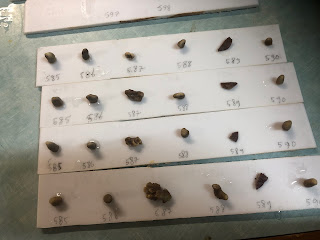Bone cutters
Way back when we were preparing for the trip last spring, Cas started a list of items he thought we should bring. At the top of the list - literally the first item - was bone cutters. I didn't know Cas very well at the time, and to be perfectly honest, I got a bit concerned about why this new postdoc thought he was going to have to cut bones in Palau. Turns out, since bones and corals are both made of calcium carbonate, bone cutters are actually pretty common in the aquarium trade. They're a really handy tool to sample corals.
Cas's bone cutters got put to good use this week. We set out to sample a few other species in the same genus as our target species, Porites lobata: P. rus and P. cylindrica. Since P. lobata has genetic lineages with different levels of heat tolerance, what about the other Porites? In 2021, I collected little tissue chips of both P. rus and P. cylindrica with Kharis. I told Cas about the project, and he had an idea: let's see if P. rus and P. cylindrica from different sites have different thermal tolerance. Maybe they also fall into different lineages like P. lobata.
 |
| My P. rus and P. cylindrica samples ready for CBASS |
Cas did the honors. One by one, he cut small pieces of each coral with his precious, terrifying tool and handed the bits to me. I handled the super glue. It took us about an hour to chop up all the corals and glue them in place. It would have taken a lot longer without the bone cutters.
I'm glad Cas planned ahead and we get to collect such cool data!
Comments
Post a Comment